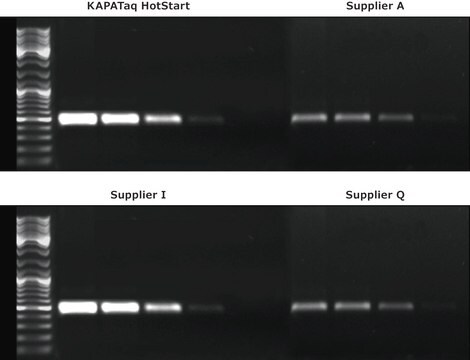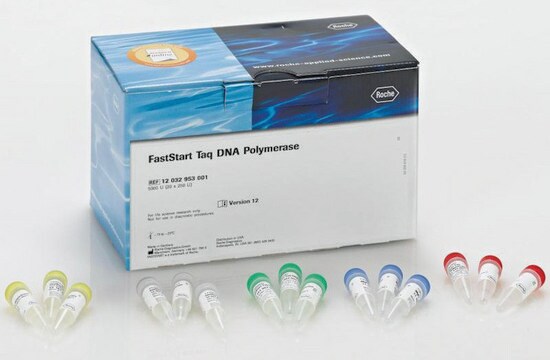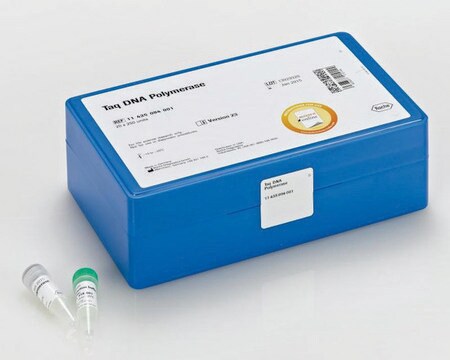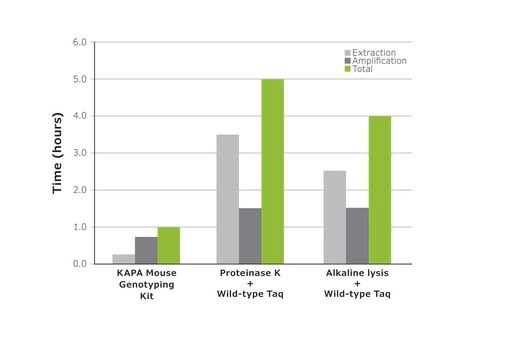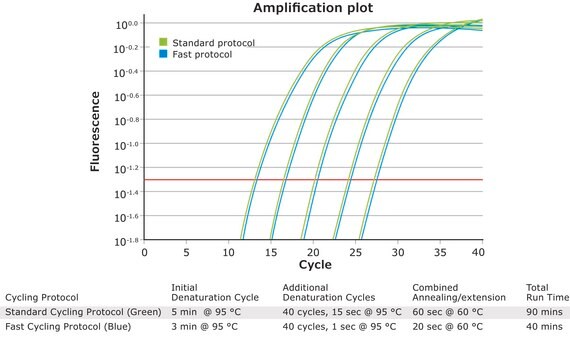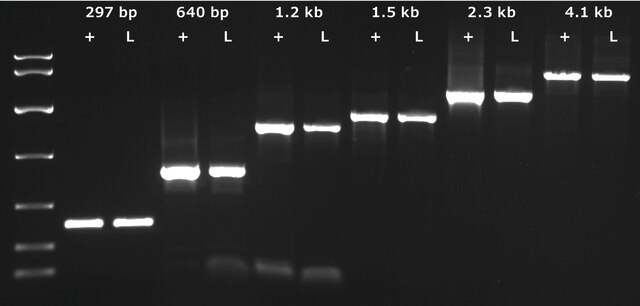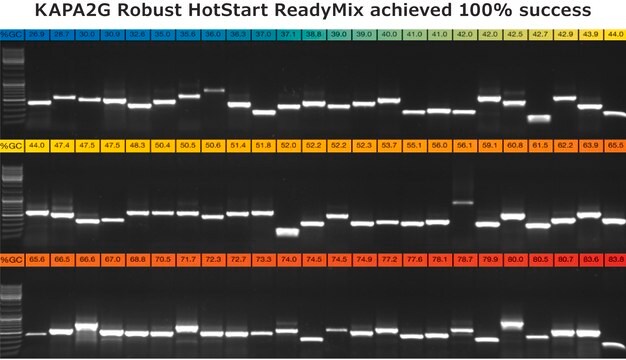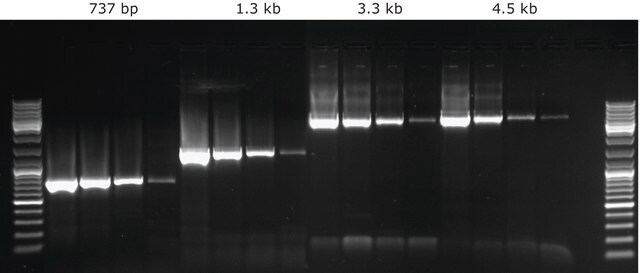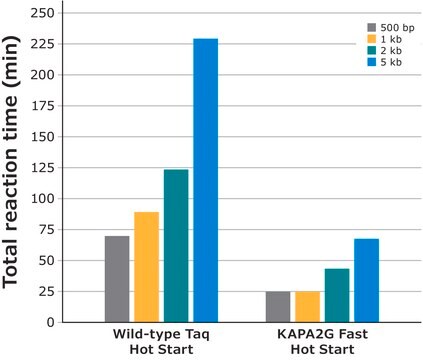Recommended Products
shelf life
≤18 mo.
Quality Level
feature
dNTPs included: no
hotstart: no
packaging
pkg of 250 U (KK1014)
pkg of 2500 U (BK1000)
pkg of 500 U (KK1015)
pkg of 5000 U (BK1002)
manufacturer/tradename
Roche
technique(s)
PCR: suitable
input
purified DNA
storage temp.
−20°C
Looking for similar products? Visit Product Comparison Guide
Application
KAPA Taq PCR Kit has been used in:
- High throughput PCR
- Amplification of low copy DNA templates
- Multiplex PCR
- Specific amplification of complex templates
- RT-PCR
- random amplified polymorphic DNA polymerase chain reaction (RAPD-PCR)
- Polymerase chain reaction (PCR)
- Genotyping
Biochem/physiol Actions
KAPA Taq PCR Kit, which contains KAPA Taq DNA Polymerase, is based on the single-subunit, wild-type Taq DNA polymerase of the thermophilic bacterium Thermus aquaticus. KAPA Taq and KAPA Taq HotStart® DNA Polymerase have 5′→3′ polymerase and 5′→3′ exonuclease activities, but no 3′ → 5′ exonuclease (proofreading) activity. The enzyme has an error rate of approximately 1 error per 2.2 x 105 nucleotides incorporated. In the hot start formulation, the KAPA Taq is combined with a proprietary antibody that inactivates the enzyme until the first denaturation step, eliminating spurious amplification products and increasing reaction efficiency and sensitivity.
Features and Benefits
High performance:
Quick Notes:
- Improved sensitivity, specificity, and yields
- Novel buffer formulation facilitates specific primer annealing, leading to higher yield of specific product
Quick Notes:
- KAPA Taq DNA Polymerase can replace any commercial Taq DNA polymerase in an existing protocol.
- The final MgCl2 concentration may need to be optimized to account for differences in buffer formulation.
- KAPA Taq Buffers contain MgCl2 at a final concentration of 1.5 mM. Buffer A is recommended as first approach and for applications requiring high yields. Buffer B is recommended for applications where high sensitivity is required (e.g. when the template is limiting). Both buffers may be evaluated to determine the buffer most suitable for a specific application.
- The KAPA Taq PCR system is suitable for the amplification of fragments up to 3.5 kb from genomic DNA or 5 kb from less complex targets.
Quality
Each batch of KAPA Taq DNA Polymerase is confirmed to contain <2% contaminating protein (Agilent Protein 230Assay). KAPA Taq Ready Mixes are subjected to stringent quality control tests, are free of contaminating exo- and endonuclease activity, and meet strict requirements with respect to DNA contamination levels.
Preparation Note
Always ensure that the product has been fully thawed and mixed before use. Reagents may be stored at 4°C forshort-term use (up to 1 month). Return to -20°C for long term storage.
Other Notes
For Research Use Only. Not for use in diagnostic procedures.
Legal Information
HOTSTART is a registered trademark of Molecular BioProducts, Inc.
Kit Components Only
Product No.
Description
- KAPA Taq Standard or HotStart® DNA Polymerase 5 U/μL
- 10X KAPA Taq Buffer A
- 10X KAPA Taq Buffer B
- MgCl2 25 mM
Storage Class Code
12 - Non Combustible Liquids
WGK
WGK 1
Flash Point(F)
does not flash
Flash Point(C)
does not flash
Certificates of Analysis (COA)
Search for Certificates of Analysis (COA) by entering the products Lot/Batch Number. Lot and Batch Numbers can be found on a product’s label following the words ‘Lot’ or ‘Batch’.
Already Own This Product?
Find documentation for the products that you have recently purchased in the Document Library.
Customers Also Viewed
SNES: single nucleus exome sequencing
Marco L Leung
Genome Biology, 16(55) (2015)
Direct conversion of mouse embryonic fibroblasts into functional keratinocytes through transient expression of pluripotency-related genes.
Iacovides D, et al.
Stem Cell Research & Therapy, 7(1), 98-98 (2016)
Improvement of poly-[gamma]-glutamic acid (PGA) producing Bacillus subtilis SBMYP-1 by N-methyl-N′-nitro-N-nitrosoguanidine (NTG) mutagenesis.
Mahidsanan T and Gasaluck P
International food research journal., 23(2), 751-751 (2016)
Demetris Iacovides et al.
Data in brief, 20, 1602-1606 (2018-09-29)
We have performed whole transcriptome sequencing of 5-FU resistant and 5-FU sensitive tumors generated in a mouse model of de novo carcinogenesis that closely recapitulates tumor initiation, progression and maintenance in vivo. Tumors were generated using the DMBA/TPA model of
Charalambos Loizides et al.
PloS one, 10(12), e0143840-e0143840 (2015-12-10)
Tumorigenesis is a complex, multistep process that depends on numerous alterations within the cell and contribution from the surrounding stroma. The ability to model macroscopic tumor evolution with high fidelity may contribute to better predictive tools for designing tumor therapy
Our team of scientists has experience in all areas of research including Life Science, Material Science, Chemical Synthesis, Chromatography, Analytical and many others.
Contact Technical Service
